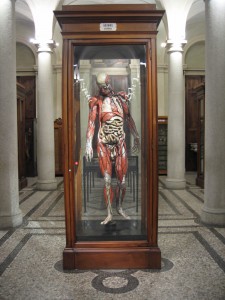I confess to being somewhat peeved this morning, on several counts.
First, I thought it was the 11th, giving me a day to be ready with a post for Darwin Day 2012.
Then, I couldn’t find any evidence of an online celebration of Darwin Day 2012, which seems to have just gone extinct some time around 2010. There are plenty of meatspace celebrations, it is true, including one that is a source of yet more peevishness.
 Yesterday, Turin University demonstrated huge adaptability in bending Darwin Day to its will. Reasoning, possibly correctly, that nobody would actually come out for an event genuinely about evolution, the University hosted, instead, a seminar on The Evolution of the Blues. I kid you not. And in the Museum of Human Anatomy, no less, where I snapped that revelatory image in November 2008. Don’t get me wrong; I think that The Evolution of the Blues is an admirable subject for a Darwin Day celebration and I can’t think of a better venue than the Museum of Human Anatomy. In fact, I wish I’d been there. But yet another source of peevishness is that the Museum shares a building with a Museum of Fruit & Veg Diversity. Wouldn’t it be nice (hint, hint) if that were the locus and subject for the University of Turin’s celebration of Darwin Day 2013?
Yesterday, Turin University demonstrated huge adaptability in bending Darwin Day to its will. Reasoning, possibly correctly, that nobody would actually come out for an event genuinely about evolution, the University hosted, instead, a seminar on The Evolution of the Blues. I kid you not. And in the Museum of Human Anatomy, no less, where I snapped that revelatory image in November 2008. Don’t get me wrong; I think that The Evolution of the Blues is an admirable subject for a Darwin Day celebration and I can’t think of a better venue than the Museum of Human Anatomy. In fact, I wish I’d been there. But yet another source of peevishness is that the Museum shares a building with a Museum of Fruit & Veg Diversity. Wouldn’t it be nice (hint, hint) if that were the locus and subject for the University of Turin’s celebration of Darwin Day 2013?
But enough whinging. Fortunately, there is something to celebrate for Darwin Day 2012: an excellent explanation by Ford Denison of some of the mysteries of the relationship between nitrogen-fixing bacteria and their plant hosts, based on a recently published paper by Ford and a couple of his ex-students. Such relationships are often called symbiosis, or mutualism, with the clear implication that both sides benefit. The central mystery of such relationships remains: what prevents cheating?
Previous work by Denison’s group had shown that the host plant sanctions rhizobia that don’t fix nitrogen. The nodules formed by non-fixing bacteria are smaller than those of bacteria that do fix nitrogen, consistent with sanctions of some sort. In keeping with the nature of natural selection, they take pains to explain that:
We have called these plant responses “sanctions”, without any implication that plants are self-aware or that sanctions will change the behavior of rhizobia, except via evolutionary decreases in the frequency of rhizobial “cheaters” over generations.
The latest paper takes things further, asking whether partial cheats, which fix a bit of nitrogen but not as much as other strains, also trigger sanctions. As Denison explains it, other researchers have shown that even though nodules of non-fixing bacteria are smaller, they contain similar numbers of rhizobia. Numbers are more important than size for bacterial evolutionary fitness, so the sanctions may not in fact be selecting against non-fixing bacteria. There’s more to the story, which remains inconclusive for now, and I urge you to head to Ford Denison’s blog to read it in full.
Darwin Day and Denison’s post also offer a timely reminder that in agriculture, based as it generally is on artificial selection, fitness, in the evolutionary sense, is seldom straightforward. Dwarf cereals, for example, are a good thing (for us, and for themselves) only if they are growing in a field of other dwarf cereals. As a spontaneous mutation in a stand of normal-height plants, they would be rapidly out-competed. Denison covers this enormous and important subject in his new book Darwinian Agriculture: How Understanding Evolution Can Improve Agriculture, which I was thrilled to learn from Amazon two days ago might be delivered a week earlier than promised.